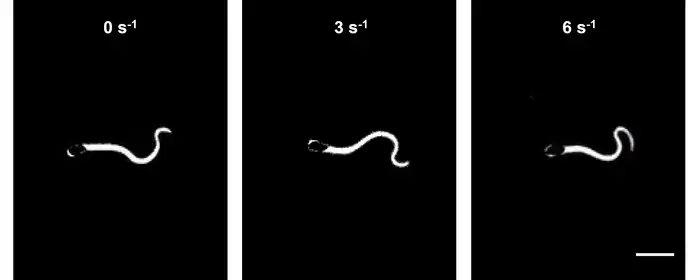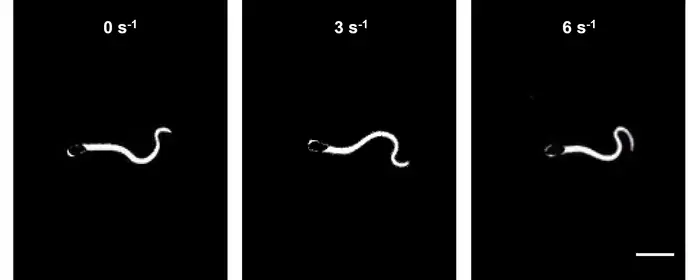Sperm can modulate their energetics by regulating their flagellar waveform—how the sperm oscillate their tails—in order to adapt to varying fluid environments, potentially optimizing their motility and navigation within the reproductive tract. This research is reported in a study publishing November 1 in the journal Cell Reports Physical Science.

Credit: Cell Reports Physical Science/Yazdan Parast et al.
Sperm can modulate their energetics by regulating their flagellar waveform—how the sperm oscillate their tails—in order to adapt to varying fluid environments, potentially optimizing their motility and navigation within the reproductive tract. This research is reported in a study publishing November 1 in the journal Cell Reports Physical Science.
“Our approach allowed us to investigate how variations in viscosity and shear rates affect sperm behavior at the single-cell level, which was not possible using traditional methods,” says senior study author Reza Nosrati of Monash University.
Biochemical and biophysical cues within the reproductive tract serve as filters against low-quality sperm and guidance mechanisms for high-quality sperm to navigate toward the egg. For example, during sexual intercourse, intensified mucus secretions within the oviduct stimulate fluid movement in the fallopian tube toward the uterus. This flow helps prevent pathogens from invading the reproductive tract by flushing them down and simultaneously selects sperm capable of swimming against the flow toward the egg via a phenomenon known as rheotaxis.
But due in part to the limitations of conventional microscopy methods and population-level studies, it has remained unclear how factors like fluid flow and viscosity interact to influence sperm flagellar beating behavior at the single-cell level. Moreover, current clinical practices largely utilize low-viscosity media and stagnant flow conditions, even though the practical advantages of considering physiologically relevant environments might be significant.
In this study, Nosrati and his team designed a “testing arena” for the sperm to observe their behavior under physiologically relevant conditions. This device leveraged microfluidics to examine sperm flagellar waveform and energetics in response to changes in flow and viscosity. By tethering bull sperm in a microchannel, the researchers exposed the same individual sperm to a range of viscosities and shear rates, which refer to the rates of change in velocity at which one layer of fluid passes over an adjacent layer. Using high-speed, high-resolution microscopy, the researchers quantified flagellar dynamics at 200 frames per second.
The findings showed that sperm flagellar waveforms are primarily influenced by viscosity rather than the shear rate, and their synergistic effect promotes energy-efficient beating behavior. The motility and energetics of sperm were less influenced by fluid flow in environments with lower viscosities. But in high-viscosity media, an increase in shear rate from 0 to 6 per second at 75 millipascal seconds reduced the flagellar curvature by 20%, and the flagellar beating frequency was highest at a shear rate of 3 per second, which is favorable for sperm rheotaxis.
According to the authors, this phenomenon suggests a potential increase in energy production and changes in flagellar beating behavior under these specific conditions to possibly enable rheotaxis and facilitate a transition from circular motion to rolling motion. This increased energetic output observed at a shear rate of 3 per second suggests that the sperm adjusts its power generation to adapt and respond to the fluid dynamics, thereby enabling efficient swimming against the flow.
Currently, the researchers are refining their imaging techniques and experimental platform for a follow-up study to examine free-swimming sperm under similar conditions. “It’s also crucial to better understand the importance of these media considerations with respect to sperm selection and fertilization,” Nosrati says. “We plan to run an animal study to evaluate how such properties can influence fertilization and embryo development in assisted reproduction to inform future treatment strategies for better outcomes.”
###
This work was supported by the Australian Research Council (ARC) Discovery Project, the Australian National Health and Medical Research Council, and Monash University.
Cell Reports Physical Science, Yazdan Parast et al. “The cooperative impact of flow and viscosity on sperm flagellar energetics in biomimetic environments” https://www.cell.com/cell-reports-physical-science/fulltext/S2666-3864(23)00469-1
Cell Reports Physical Science (@CellRepPhysSci), published by Cell Press, is a broad-scope, open access journal that publishes cutting-edge research across the spectrum of the physical sciences, including chemistry, physics, materials science, energy science, engineering, and related interdisciplinary work. Visit https://www.cell.com/cell-reports-physical-science/home. To receive Cell Press media alerts, please contact [email protected].
Journal
Cell Reports Physical Science
DOI
10.1016/j.xcrp.2023.101646
Method of Research
Experimental study
Subject of Research
Cells
Article Title
The cooperative impact of flow and viscosity on sperm flagellar energetics in biomimetic environments
Article Publication Date
1-Nov-2023





